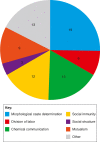Ant genomics sheds light on the molecular regulation of social organization
- PMID: 23895728
- PMCID: PMC4053786
- DOI: 10.1186/gb-2013-14-7-212
Ant genomics sheds light on the molecular regulation of social organization
Abstract
Ants are powerful model systems for the study of cooperation and sociality. In this review, we discuss how recent advances in ant genomics have contributed to our understanding of the evolution and organization of insect societies at the molecular level.
Figures



References
-
- Holldobler B, Wilson E. The Ants. Belknap Press; 1990.
-
- Nygaard S, Zhang G, Schiott M, Li C, Wurm Y, Hu H, Zhou J, Ji L, Qiu F, Rasmussen M, Pan H, Hauser F, Krogh A, Grimmelikhuizen CJP, Wang J, Boomsma J. The genome of the leaf-cutting ant Acromyrmex echinatior suggests key adaptations to advanced social life and fungus farming. Genome Res. 2011;14:1339–1348. doi: 10.1101/gr.121392.111. - DOI - PMC - PubMed
-
- Smith CD, Zimin A, Holt C, Abouheif E, Benton R, Cash E, Croset V, Currie CR, Elhaik E, Elsik CG, Fave MJ, Fernandes V, Gadau J, Gibson JD, Graur D, Grubbs KJ, Hagen DE, Helmkampf M, Holley J-A, Hu H, Viniegra ASI, Johnson BR, Johnson RM, Khila A, Kim JW, Laird J, Mathis KA, Moellert JA, Muñoz-Torres MC, Murphy MC. et al.Draft genome of the globally widespread and invasive Argentine ant (Linepithema humile). Proc Natl Acad Sci USA. 2011;14:5673–5678. doi: 10.1073/pnas.1008617108. - DOI - PMC - PubMed
-
- Smith CR, Smith CD, Robertson HM, Helmkampf M, Zimin A, Yandell M, Holt C, Hu H, Abouheif E, Benton R, Cash E, Croset V, Currie CR, Elhaik E, Elsik CG, Fave M-J, Fernandes V, Gibson JD, Graur D, Gronenberg W, Grubbs KJ, Hagen DE, Viniegra ASI, Johnson BR, Johnson RM, Khila A, Kim JW, Mathis KA, Murphy MC. et al.Draft genome of the red harvester ant Pogonomyrmex barbatus. Proc Natl Acad Sci USA. 2011;14:5667–5672. doi: 10.1073/pnas.1007901108. - DOI - PMC - PubMed
Publication types
MeSH terms
Grants and funding
LinkOut - more resources
Full Text Sources
Other Literature Sources

